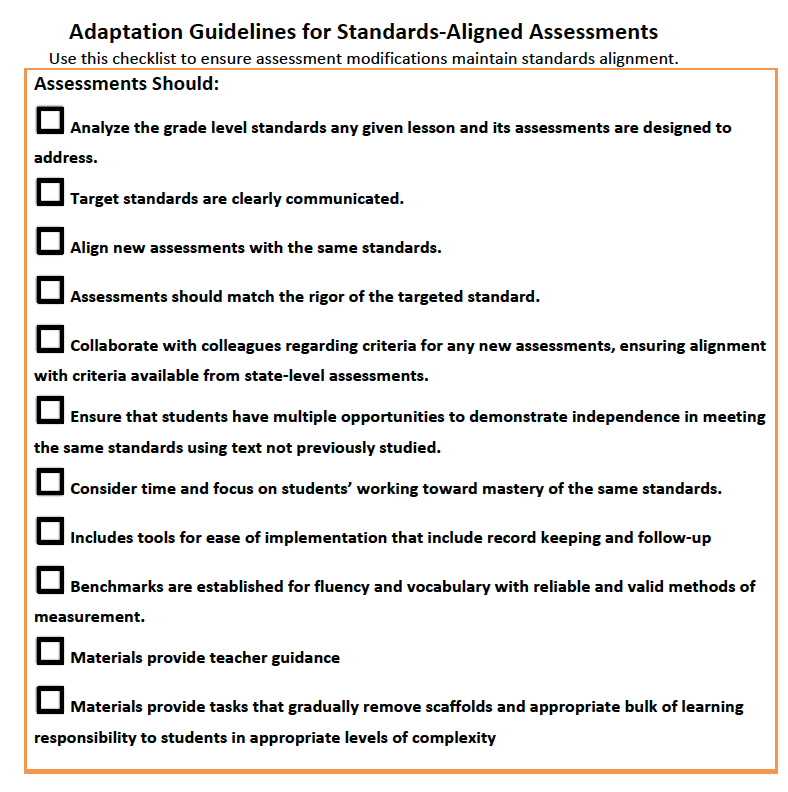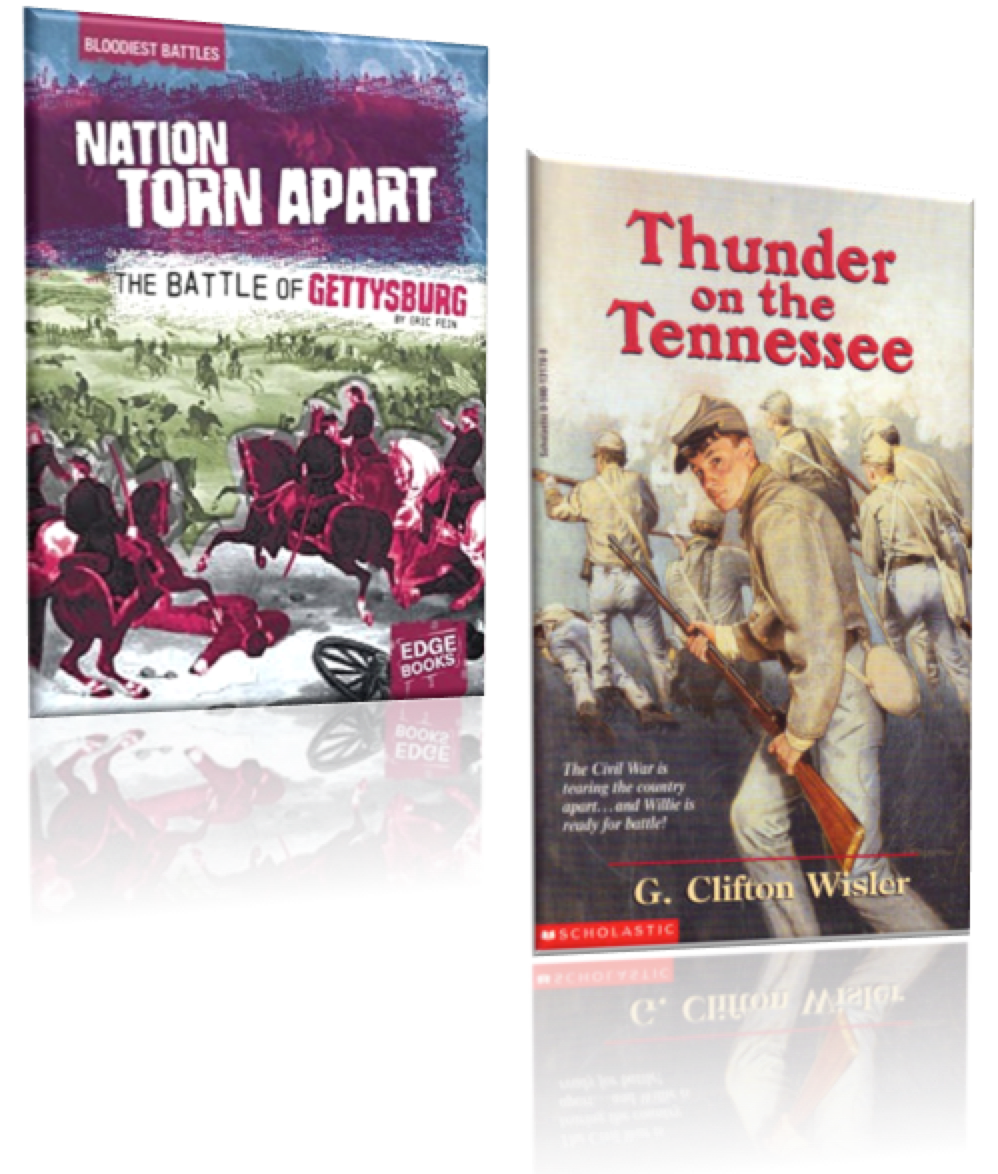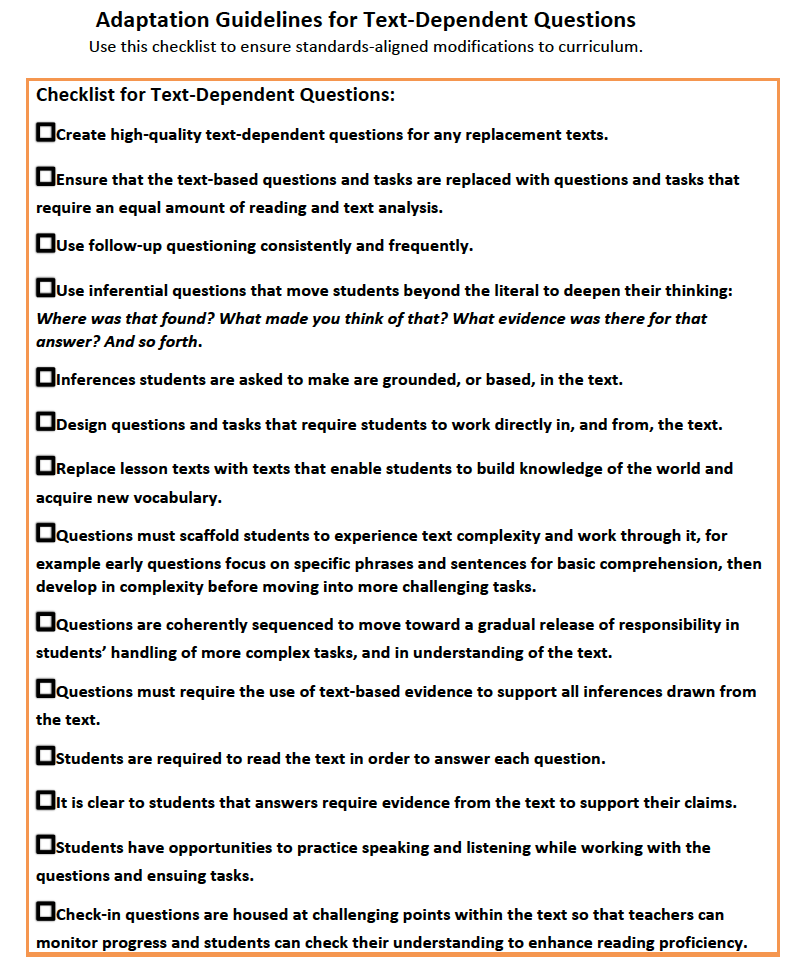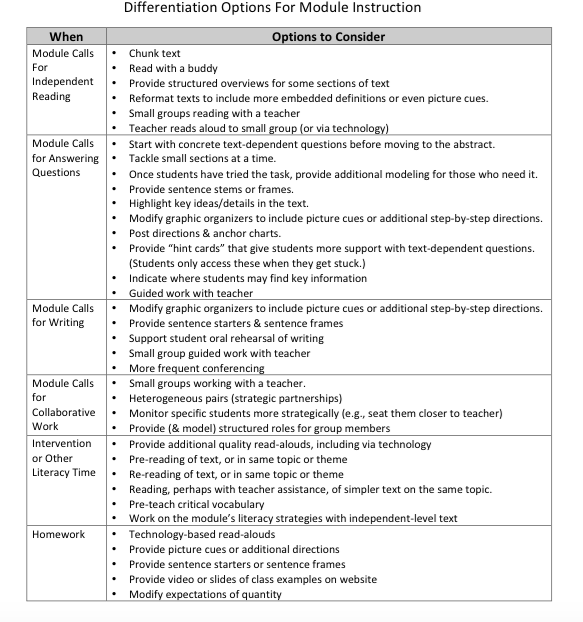Selecting and Modifying Materials to Differentiate
| Site: | Literacy Solutions On-Demand Courses |
| Course: | Cross-Cultural Communications and Understanding, Grades K-12 - No. ELL-ED-260 |
| Book: | Selecting and Modifying Materials to Differentiate |
| Printed by: | Guest user |
| Date: | Thursday, December 18, 2025, 10:55 PM |
Description
no insert
1. Curriculum Modifications for Differentiation
Often differentiation requires modifications to curriculum in order to properly, and most effectively, differentiate. How often have we been told to work with, or within, a curriculum that wasn't exactly right for your students? It could be in the pacing of tasks, assignments, the ways in which they are differentiated (or not differentiated), or even in the reading requirements or levels of questioning. Let's face it: not all of our students read at the same level, nor do they advance in their skills at the same rate. In this Age of the Common Core and of the Florida State Standards however, many teachers are either unsure of how to make adjustments to differentiate because they do not want to interfere with the integrity of the standards alignment, or interrupt the expectations designed within them.
The good news is that we can, and should, make adjustments to curriculum when we need to - this hasn't changed since the Common Core. How and what to adjust, along with when, is where knowledge becomes powerful. Let's look at precisely how. With differentiation in mind, let's see what the guidelines are for making changes to an FSS-aligned curriculum:
Download the following resources from the Course Objectives | Research | Materials folder:
-
-
- Task Modifications Checklist
- Assessment Modifications Checklist
- Modifications to Text Dependent Questions Checklist
-
Assessment Modifications
Assessment should clearly communicate the target standards, with ensuing materials offering tools for ease of implementation that include systems for record keeping and follow-up. Establishing predictive  benchmarks for fluency and vocabulary is also necessary, and should include reliable and valid methods of measurement.
benchmarks for fluency and vocabulary is also necessary, and should include reliable and valid methods of measurement.
All assessment aligned materials should provide teacher guidance, i.e., strategy guides an checklists, to provide scaffolding for students with tasks that can gradually remove the scaffolds and appropriate the bulk of learning responsibility to students within appropriate levels of complexity.
These are the basic rules for modification of assessments:
- Analyze the grade level standards any given module and its assessments are designed to address.
- Align new assessments with the same standards.
- Assessments should match the rigor of the targeted standard
- Collaborate with colleagues regarding criteria for any new assessments, ensuring alignment with criteria available from state-level assessments.
- Ensure that students have the multiple opportunities to demonstrate independence in meeting the same standards using text not previously studied.
- Consider time and focus on students’ working toward mastery of the same standards.
Recommendations for Working With Challenging Text:
The FSS require that students read text with increased complexity and that have complex tasks that grow their independence toward career and college readiness. Given this, texts at each grade should achieve the following:
- Align in complexity to the requirements outlined in the standards.
- Allow all students extensive opportunities to work within grade-level complex text.

- User shorter, challenging text chunked strategically for close reading and re-reading at grade-specific, regular intervals.
- Include novels, plays, and other extended full-length material with opportunities for close reading.
- Provide additional materials to increase independent reading of text with wide appeal to interest, and to develop student knowledge base and joy for reading.
- Include a greater focus on informational text in elementary school, and literary nonfiction in grades 6-12.
- Balance measures of literary and informational text.
- Increase literary nonfiction in 6-12 ELA
- Provide multiple opportunities for close reading and re-reading.
- Include text types named in the standards
- Include a sequencing of texts with specific anchor texts for close and careful reading chosen.
Guidelines for Text Modification:
- Analyze the quantitative and qualitative complexity factors of the texts in use.
- Analyze content knowledge and vocabulary to be gained from any given lesson's text.
- Analyze the standards lesson texts were chosen to address.
- Determine the intent of texts for use: for close reading, independent, or for research.
- Replace texts with texts of similar complexity.
- Replace texts with texts that enable students to build knowledge of the world and acquire new vocabulary.
- Replace texts with those that offer opportunities for students to meet the same standards.
- Replace texts with those that serve the same purpose.
Modification of Text Dependent Questions:
Text dependent questions help students to better understand the intended author message by focusing exclusively on the text, rather than what they might perceive that text with or without reading it. High quality text-dependent questions go beyond what is directly stated in the text by requiring students to make inferences. Close reading of text is a crucial thread throughout all grades, with close attention paid to the text to answer and respond to it fully via text-dependent questions.
High quality, effective text-dependent questions will focus students on specific key words, key phrases and ideas contained only within that text. They scaffold from the simple and basic, to broader arguments and details that explore impact on other facets of the text. Text-dependent questions will “linger over” specific sentences and phrases to build on successive questions to ensure students stay focused, and read closely to comprehend as much as possible.
Guidelines for Creating and/or Modifying Text-Dependent Questions:
- Create high-quality text-dependent questions for any texts that are replaced.
- Ensure that the text-based questions and tasks are replaced with questions and tasks that require an equal amount of reading and text analysis.
- Use follow-up questioning consistently and frequently.
- Use inferential questions that move students beyond the literal to deepen their thinking: Where was that found? What made you think of that? What evidence was there for that answer? And so forth.
- Design questions and tasks that require students to work directly in, and from, the text.
Text Replacement:
The FSS require that students be able to read closely to gain knowledge from texts, and is a key priority for students to be able to demonstrate their independent ability to read grade-level complex text. Of all the modifications, task modification requires the most attention. Guidelines for creating and adjusting tasks that align with the Florida State Standards include:
- Scaffolding that enables all students to experience rather than avoid the complexity of the text, with appropriate guidance as needed.
- Reading strategies that support comprehension of specific texts with a focus on building knowledge and insight.
- Close reading that requires a gathering of knowledge from specific texts.
- Whole and small group design with individual instruction that cultivates student responsibility and builds learner capacity.
- Questions and tasks that require careful comprehension of the text in order to answer questions, evaluate information and/or make important interpretations.
- Materials that chunk tasks, organize information, and scaffold thinking.
- Materials that offer consistent assessment opportunities that measure progress over time.
- A prevalence of academic vocabulary across multiple disciplines that require students to draw meaning from context.
Guidelines for Modifying Tasks:
- Balance the percentage of time spent working in each lesson vs. listening to the teacher explain or model, with lesson explaining and listening, and more in working.
- Build lessons that maintain a similar degree of student work time.
- Build lessons that are of high quality with text-dependent questions for any and all replacement text.
- Ensure that text-based questions and tasks are replaced with questions and tasks that require an equal amount of reading and analysis.
- Replace tasks with tasks that you and your students prefer that serve similar instructional purposes while maintaining the same rigor, such as a compare/contrast chart for a Venn Diagram.
- Design tasks that require students work directly from text.
- Use regular follow-up questions.
- Analyze the standards the tasks are designed to address.
- Analyze daily and sustained writing purposes and types that students are held accountable for.
- Analyze lessons for the methods students use to enlist peer thinking.
- Analyze lessons for student reflection on progress and growth.
- Adapt tasks and differentiate in ways that introduce additional scaffolding for those who need it.
- Design lesson series that scaffold.
Achievethecore.org: Revised Publishers’ Criteria for the Common Core Standards in English Language Arts and Literacy, Grades K-2
2. Spontaneous Intervention
Strategies for ELLs
There is something called Spontaneous Intervention, and we have all responded in this way to our students at some point. It is when we intervene without planning, because they reacted either academically or behaviorally without anticipation. We typically ask questions in anticipation of student response as a way of scaffolding or leading students into material. Teacher speech and spontaneous interventions have become the subject of increasing research to result in improved strategies in response to unpredictable student academic behaviors (Strickland, 2003).
According to Strickland et al. (2003), the classroom talk typically focuses on actions that are initiated, in response to something, or as an evaluation - IRE. This classroom talk can take the form of a question, a student response, or an evaluation of a student academic action or response. Here are some examples:
T: What did Scout believe happened to Mayella Ewell? (Initiation act).
S: That she was actually hurt by her father. (Response act).
T: Good, that’s right. (Evaluation act).
When initiated by the Teacher: It is typical, and also traditionally advisable, to invite students into the discussion whenever possible, either invite several students, or invite a few. What does this look like? Let's first think about what happens when a student responds incorrectly. It is usually tempting to call on someone else until the correct answer is given, or evaluate that they are wrong and move on. By clarifying students' thinking, or closing it down can lead into a trajectory of wrong answers or lack of sustained attention on the right answers. By breaking down and looking at the wrong answer, boosting the students' to troubleshoot, problem solve, and correct their own mistakes builds their capacity to think and learn independently or "spontaneously".
Solutions for ELLs:
1. Allow students opportunities to read and write in their own language in less difficult text at their independent or easy reading levels. Scaffold by chunking the text, or reading short pieces interspersed with questions, short discussions, or short written responses based on what they know in their own language.
2. Provide them with reading of cultural and personal interest to aid in both comprehension, vocabulary context, and word recognition. When possible, provide them with plenty of:
- Books at multiple reading levels.
- Uninterrupted reading time with opportunities to read in their own language.
- Themes that reflect their culture and background knowledge
3. Encourage participation by using predictable text and with small group discussions that share reading experiences and how they relate personally and culturally to those experiences.
4. Peer coaching throughout the writing process with a focus on communicating goals and trouble spots in their writing, with ample opportunity to edit, give, and receive feedback recursively.
5. Encourage students to write from what they know and feel passionately about; allow them to select their own topics.
References: Ganske, Kathy; Monroe, Joanne K., Strickland, Dorothy, S. Questions teachers ask about struggling readers and writers. Reading Teacher, Oct. 2003, Vol. 57, Issue 2.
3. Modification Examples for Grades 3-8
Struggling learners and English Language Learners benefit from additional scaffolding, and this is another way to modify modules when necessary to:
- Provide students with background information about the topic being studied
- Develop contextualized academic vocabulary
- Build deeper understanding by previewing material in native languages, or easier language, when possible and when necessary.
Struggling students benefit from interactive discussions in pairs, small groups, or the whole class. Discussions can be structured as:
- Brainstorm Concept Map – whole class
- Completing Graphic Organizers – small group, pair, or individual work with sharing
- Plus-Minus-Interesting – whole class, small group or pair work
- Round Robin Discussions – whole class or in groups
- Collaborative projects – whole class or in groups
- Small Group Interviews – Individual interactions with first-person sources
Building Academic Vocabulary
Pre-Reading Sentence Starters
-
Select vocabulary related to the lesson or unit and create sentences which employ the word but require completion by the students.
-
Use only speaking and listening skills initially to introduce and have students practice carefully selected academic vocabulary and sentences.
-
Students employ higher order thinking skills in making “educated guesses” about what the words may mean.
-
Reinforcement of academic vocabulary and sentences in written form can be introduced afterwards, via a variety of approaches .
Differentiation Options (this and other resources can be found in the Course Objectives | Research | Materials folder

